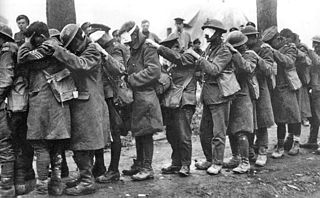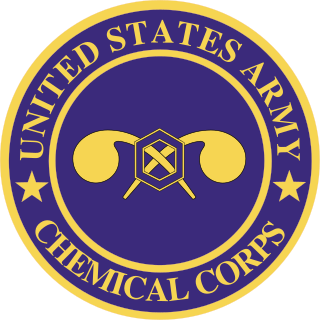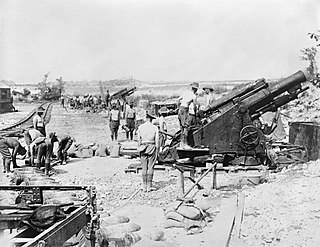Related Research Articles

The Hanford Site is a decommissioned nuclear production complex operated by the United States federal government on the Columbia River in Benton County in the U.S. state of Washington. The site has been known by many names, including Hanford Project, Hanford Works, Hanford Engineer Works and Hanford Nuclear Reservation.

Chemical warfare (CW) involves using the toxic properties of chemical substances as weapons. This type of warfare is distinct from nuclear warfare, biological warfare and radiological warfare, which together make up CBRN, the military acronym for nuclear, biological, and chemical, all of which are considered "weapons of mass destruction" (WMDs). None of these fall under the term conventional weapons which are primarily effective due to their destructive potential. In theory, with proper protective equipment, training, and decontamination measures, the primary effects of chemical weapons can be overcome. In practice, they continue to cause much suffering, as most victims are defenseless. The threat and the perceived threat have become strategic tools in planning both measures and counter-measures.

Aberdeen Proving Ground (APG) is a U.S. Army facility located adjacent to Aberdeen, Harford County, Maryland, United States. Part of the facility is a census-designated place (CDP), which had a population of 3,116 at the 2000 census, and 2,093 as of the 2010 census. More than 7,500 civilians and 5,000 military personnel work at APG.

Iraq actively researched and later employed weapons of mass destruction (WMD) from 1962 to 1991, when it destroyed its chemical weapons stockpile and halted its biological and nuclear weapon programs as required by the United Nations Security Council. The fifth President of Iraq, Saddam Hussein, was internationally condemned for his use of chemical weapons during the 1980s campaign against Iranian and Kurdish civilians during and after the Iran–Iraq War. In the 1980s, Saddam pursued an extensive biological weapons program and a nuclear weapons program, though no nuclear bomb was built. After the Persian Gulf War (1990–1991), the United Nations located and destroyed large quantities of Iraqi chemical weapons and related equipment and materials; Iraq ceased its chemical, biological and nuclear programs.

The use of toxic chemicals as weapons dates back thousands of years, but the first large scale use of chemical weapons was during World War I. They were primarily used to demoralize, injure, and kill entrenched defenders, against whom the indiscriminate and generally very slow-moving or static nature of gas clouds would be most effective. The types of weapons employed ranged from disabling chemicals, such as tear gas, to lethal agents like phosgene, chlorine, and mustard gas. This chemical warfare was a major component of the first global war and first total war of the 20th century. The killing capacity of gas was limited, with about ninety thousand fatalities from a total of 1.3 million casualties caused by gas attacks. Gas was unlike most other weapons of the period because it was possible to develop countermeasures, such as gas masks. In the later stages of the war, as the use of gas increased, its overall effectiveness diminished. The widespread use of these agents of chemical warfare, and wartime advances in the composition of high explosives, gave rise to an occasionally expressed view of World War I as "the chemist's war" and also the era where weapons of mass destruction were created.

Unexploded ordnance, unexploded bombs (UXBs), and explosive remnants of war (ERW) are explosive weapons that did not explode when they were employed and still pose a risk of detonation, sometimes many decades after they were used or discarded. UXO does not always originate from wars; areas such as military training grounds can also hold significant numbers, even after the area has been abandoned. UXO from World War I continue to be a hazard, with poisonous gas filled munitions still a problem. When unwanted munitions are found, they are sometimes destroyed in controlled explosions, but accidental detonation of even very old explosives also occurs, sometimes with fatal results.

White phosphorus munitions are weapons which use one of the common allotropes of the chemical element phosphorus. White phosphorus is used in smoke, illumination, and incendiary munitions, and is commonly the burning element of tracer ammunition. Other common names include WP and the slang term "Willie Pete" or "Willie Peter" derived from William Peter, the World War II phonetic alphabet for "WP", which is still sometimes used in military jargon. White phosphorus is pyrophoric, burns fiercely, and can ignite cloth, fuel, ammunition, and other combustibles.
Camp Leach was the name the U.S. military used for the segment of the Washington, D.C. main campus of American University during World War I and World War II. The site is now in Spring Valley.

The Umatilla Chemical Depot, (UMCD) based in Umatilla, Oregon, was a U.S. Army installation in the United States that stored chemical weapons. The chemical weapons originally stored at the depot consisted of various live munitions and storage containers each holding 1 short ton GB or VX nerve agents or HD blister agent. All munitions had been safely destroyed by 2011 and base closure operations are expected to be completed by 2018, after several years of delays.

Spring Valley is a largely residential neighborhood in Ward 3, Northwest Washington, D.C. As of July 2021, it was the most expensive neighborhood in the District, with homes selling at a median price of $1.465 million.

An entrenching tool (U.K.), intrenching tool (U.S.A.), E-tool, or trenching tool is a digging tool used by military forces for a variety of military purposes. Survivalists, campers, hikers and other outdoors groups have found it to be indispensable in field use. Modern entrenching tools are usually collapsible and made using steel, aluminum, or other light metals.

Beginning in the mid-1930s, Japan conducted numerous attempts to acquire and develop weapons of mass destruction. The 1943 Battle of Changde saw Japanese use of both bioweapons and chemical weapons, and the Japanese conducted a serious, though futile, nuclear weapon program.

The Chemical Corps are the branch of the United States Army tasked with defending against chemical, biological, radiological, and nuclear (CBRN) weapons. The corps was founded as the U.S. Chemical Warfare Service (CWS) during World War I. Its name was changed to the Chemical Corps in 1946. For most of its history, the Chemical Corps was tasked with delivering chemical weapons rather than defending against them.

The Ordnance BL 9.2-inch howitzer was a heavy siege howitzer that formed the principal counter-battery equipment of British forces in France in World War I. It equipped a substantial number of siege batteries of the Royal Garrison Artillery. It remained in service until about the beginning of World War II.

Saddam Hussein (1937–2006) initiated an extensive biological weapons (BW) program in Iraq in the early 1980s, despite having signed the Biological Weapons Convention (BWC) of 1972. Details of the BW program—along with a chemical weapons program—surfaced only in the wake of the Gulf War (1990–91) following investigations conducted by the United Nations Special Commission (UNSCOM) which had been charged with the post-war disarmament of Saddam's Iraq. By the end of the war, program scientists had investigated the BW potential of five bacterial strains, one fungal strain, five types of virus, and four toxins. Of these, three—anthrax, botulinum and aflatoxin—had proceeded to weaponization for deployment. Because of the UN disarmament program that followed the war, more is known today about the once-secret bioweapons program in Iraq than that of any other nation.

A chemical weapon (CW) is a specialized munition that uses chemicals formulated to inflict death or harm on humans. According to the Organisation for the Prohibition of Chemical Weapons (OPCW), "the term chemical weapon may also be applied to any toxic chemical or its precursor that can cause death, injury, temporary incapacitation or sensory irritation through its chemical action. Munitions or other delivery devices designed to deliver chemical weapons, whether filled or unfilled, are also considered weapons themselves."

The 4.7-inch gun M1906 was designed and issued by the US Army Ordnance Department beginning in 1906, with the first units receiving the weapon in 1911. It was of the field gun type. It was one of very few pre-war US artillery designs selected for wartime production in World War I, although few of these weapons were delivered to France and used in action. A combination of a limited pre-war munitions industry, the short (19-month) US participation in the war, technical problems with large-scale production, and the ready availability of munitions overseas led to this.
The United States chemical weapons program began in 1917 during World War I with the creation of the U.S. Army's Gas Service Section and ended 73 years later in 1990 with the country's practical adoption of the Chemical Weapons Convention. Destruction of stockpiled chemical weapons began in 1985 and is still ongoing. The U.S. Army Medical Research Institute of Chemical Defense (USAMRICD), at Aberdeen Proving Ground, Maryland, continues to operate.
References
- 1 2 3 Gross, Daniel A. (Spring 2015). "Chemical Warfare: From the European Battlefield to the American Laboratory". Distillations. 1 (1): 16–23. Retrieved March 20, 2018.
- 1 2 Gordon, Martin K.; Sude, Barry R.; Overbeck, Ruth Ann; Hendricks, Charles (1994). Final Report: A Brief History of the American University Experiment Station and U. S. Navy Bomb Disposal School, America University (PDF). U. S. Army Corps of Engineers. Retrieved 13 April 2017.
- 1 2 3 4 Albright, Richard D. (2012). Cleanup of chemical and explosive munitions : locating, identifying contaminants, and planning for environmental remediation of land and sea military ranges and ordnance dumpsites (2nd ed.). Amsterdam: Elsevier/William Andrew. pp. 137–240. ISBN 978-1-4377-3477-5 . Retrieved 13 April 2017.
- ↑ The American University Courier. 1921-01-01.
- 1 2 Ruane, Michael E. (October 6, 2009). "Detector Joins Hunt for WWI Munitions in D.C." The Washington Post. Retrieved 13 April 2017.
- 1 2 3 4 Ashooh, Emma (December 7, 2015). "A Hidden History: American University's Role in World War I". American Word. Retrieved 13 April 2017.
- ↑ Acharya, Sally (August 9, 2010). "Digging up the dirt from World War I" (PDF). News at AU. Retrieved 13 April 2017.
- ↑ Vogel, Steve (October 30, 2007). "Army Digging To Recover Old Gas Shells". The Washington Post. Retrieved 13 April 2017.
- ↑ Karas, Rachel S. (November 29, 2012). "House coming down on former chemical weapons site in D.C." The Washington Post. Retrieved 13 April 2017.